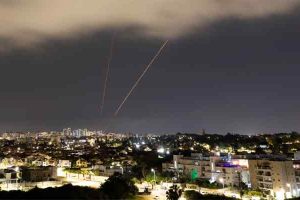
bdmetronews Desk ॥ There may soon be two nuclear powers on the Korean Peninsula. Are South Korean Submarines About to Go Nuclear?
Since his election in 2017, South Korean president Moon Jae-in has transformed his country’s diplomatic posture towards North Korea from one of confrontation to almost aggressive engagement.
However, that didn’t prevent Moon from attending the launch ceremony on September 14, 2018, of large new missile submarine from a shipyard on Geoje island, near Pusan.
“Our path to peace will not end when accompanied by a strong military and strong defense,” he remarked.
The new vessel, designed to unleash cruise and ballistic missiles on land targets and hunt down North Korea’s own missile submarines, is the first of nine planned KSS-III submarines to be built by domestic firms Daewoo and Hyundai at a cost of $700 million to $1 billion each.
The lead ship Dosahn Ahn Chango is named after a legendary Korean independence activist. This is fitting because South Korea’s ambitious plans for the class may lay the groundwork for strategic capabilities increasing Seoul’s independence from its historic alliance with Washington.
The KSS-III is South Korea’s first domestically-designed submarine and embodies the third phase of South Korea’s attack submarine program begun in the 1990s. For the first two phases, South Korea imported or license-built nine improved variants of the German Type 209 submarine (the Chang Bogo-class), followed by nine more advanced Type 214 submarines (Son Won-il-class).
Like the Type 214 and the Type 218 Invincible recently launched by Singapore, the KSS-III has an advanced hydrogen fuel-cell air-independent propulsion system. Traditional diesel-electric submarines must periodically surface or snorkel to run their air-breathing diesel-engines to recharge batteries—exposing themselves to detection and attack. However, an AIP submarine can generate enough electricity while underwater to sustainably cruise at slow speeds (around five knots) for weeks—though it can still briefly surge to 20 knots in emergencies.
Fuel-cell AIP is quieter and more efficient than the Stirling heat-cycle AIP systems used on Japanese and Chinese submarines. Moreover, the KSS-III’s configuration reportedly has 20 percent greater endurance. Given the proximity of South Korea’s potential adversaries, the submarine’s fifty-day endurance and reported ten thousand nautical mile range is more than adequate.
Seventy-six percent of the KSS-III is reportedly built with domestic components, including the vessel’s Naval Shield combat system integrating sensors and controls for the crew, and its multiple sonars. The sub’s ultra-quiet indigenously-designed, seven-bladed skewback propeller remains censored in official photos.
However, the KSS-III does incorporate foreign hardware, including the quiet pressurized torpedo loading and launch system used in the British Royal Navy’s Astute-class submarines. The KSS-III’s Spanish Pegaso electromagnetic sensor (ESM) allows it to discreetly detect and identify the emissions of opposing sub-hunters, and it can also spy on nearby vessels using a French-designed non-penetrating optronic mast—functionally a stealthy hi-tech periscope loaded with electro-optical sensors.
The 83-meter long KSS-III displaces more than twice as much as South Korea’s other subs at 3,700 tons submerged. The crew of 50 reportedly benefits from individual beds instead of having to share ‘hot bunks’, and enlarged food stores to sustain long-range patrols.
However, the vessel’s bulk is primarily due to the six Korean-designed vertical launch systems (VLS) on its spine—making her the only VLS-equipped diesel-electric submarine in service save for a lone Chinese test-bed submarine. While other subs can launch missiles from their torpedo tubes, a VLS allow for rapid ‘ripple-firing’ more likely to overwhelm an enemy.
Currently, the Dosahn Ahn-Chang’s cells can carry surface-skimming Hyunmoo-3C land-attack cruise missiles with 1,100-pound warheads. Guided by inertial navigation, GPS and a terrain-imaging system, these can strike targets up to 930 miles away—meaning they could hit anywhere in North Korea and well beyond.
However, in 2016 South Korean military officials announced the KSS-III would also be capable of launching submarine-launched ballistic missiles (SLBMS), which arc high up towards space before plunging down towards their targets at greater speeds.
As nuclear ballistic missile armed submarines are the gold-standard of unstoppable nuclear deterrence, Seoul may be quietly laying the foundations for deploying its own sea-based nuclear deterrence.







